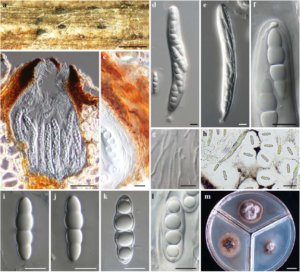Lophiotrema eburnoides Kaz. Tanaka, A. Hashim. & K. Hiray.
Index Fungorum number: IF551065, Facesoffungi number: FoF 00495; Fig. 1
Etymology – In reference to the ascospore similarity of the taxon to Massarina eburnea.
Holotype – HHUF 30079
Saprobic on Vitis coignetiae. Sexual morph Ascomata 240 – 300 μm high, 150 – 300 μm diam., scattered, immersed, erumpent at the beak, subglobose in section. Neck 40 – 50 μm high, composed of carbonaceous, black, thick-walled cells, without clypeus, with a slit-like ostiole and periphyses. Peridium 5 – 10 μm thick, composed of 2 – 4 layers of polygonal to elongate, thin-walled cells (3.5 – 5 × 2 – 3 μm). Hamathecium numerous, trabeculate, 1 – 2 μm wide, septate, branched and anastomosed. Asci (125–) 138 – 175 × 15 – 20 μm (x̄ = 150 × 17.9 μm, n = 27), 8 – spored, numerous, bitunicate, fissitunicate, cylindrical, with a short stipe (8 – 18 μm long, x̄ = 14.1 μm, n = 19), apically rounded with an ocular chamber. Ascospores 30 – 37 × (6–) 7 – 9 μm (x̄ = 32.9 × 8.3 μm, n = 42), L/W 3.5 – 4.5 (x̄ = 4,n = 42), broadly fusiform with rounded ends, mostly straight to slightly curved, 1 (–3)-septate, with a primary septum nearly median (0.49 – 0.54, x̄ = 0.51, n = 42), hyaline, smooth-walled, guttulate when young, with an entire gelatinous sheath (3 – 15 μm wide at sides). Asexual morph Undetermined.
Culture characters – Colonies on PDA, pale mouse grey with an entire olivaceous margin; on MEA, olivaceous with white margin, with hyaline exudates on the surface; on CMA, grey olivaceous in the centre. On rice straw agar (RSA: Tanaka and Harada 2003a), numerous ascomata are produced on the surface of rice straw. Ascospores are slightly wider than those on natural specimen, 31 – 36 × 9 – 11 μm (x̄ = 33.2 × 9.7 μm, n = 20), L/W 2.9 – 3.8 (x̄ = 3.4, n = 20), with a submedian primary septum (0.51 – 0.56; x̄ = 0.53, n = 20).
Material examined – JAPAN, Hokkaido, Notsuke, Bekkai, Keneyaushubetsu-river, near Mannen-bashi, on vines of Vitis coignetiae (Vitaceae), 8 September 2003, K. Tanaka & S. Hatakeyama, KT 1424 (HHUF 30079, holotype designated here); ex-type living cultures, JCM 17826, MAFF 242970. GenBank ITS: LC001709; LSU: LC001707; SSU: LC001706.
Notes – Morphological features of this species, such as compressed beak of ascomata with a slit ostiole, cylindrical asci with a short stipe (mostly less than 15 μm long), and 1 (–3)- septate ascospores with an entire sheath, agree with the generic concept of the genus Lophiotrema recently circumscribed (Hirayama and Tanaka 2011). This species can be distinguished from other taxa in Lophiotrema (Tanaka and Harada 2003b; Zhang et al. 2009b) by its relatively large ascospores. A BLAST search of the GenBank database with the 28S and ITS sequences of L. eburnoides indicated that it is most close to L. vagabundum (GenBank AF383954; Identities = 487/491 (99.1 %), Gaps = 2/491 (0.4 %)), but the latter species has smaller ascospores (20 – 26 (–29) × 4 – 5.5 μm; Tanaka and Harada 2003b).

Fig. 1 Lophiotrema eburnoides (holotype). a Ascomata on host surface b Ascoma in longitudinal section c Peridium d, e Asci f Ascus apex g Pseudoparaphyses h Ascospores in India ink i–l Ascospores m Colonies on PDA (upper), MEA (left), and CMA (right) after 30 d at 20 °C in the dark. a-g, i, j from HHUF 30079 (holotype); h, k–m from JCM17826 = MAFF 242970 (ex-holotype isolate). Scale bars: a = 500 μm, b = 50 μm, c-g, i-l = 10 μm, h = 50 μm, m = 1 cm.
